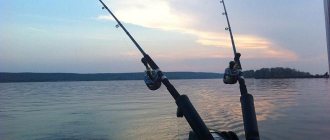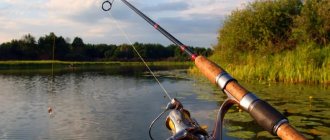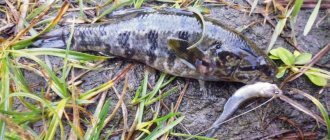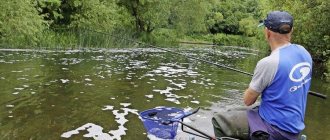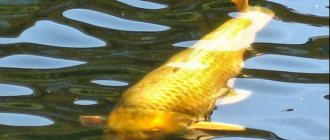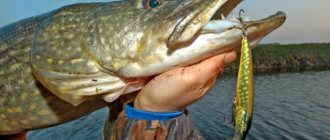Versha
One of the types of fishing tackle is tops, which were known back in Ancient Rus' (you can read about this in “The Wise Minnow” by Saltykov-Shchedrin). This tackle is made from willow twigs and has a frame cone-shaped design. In some regions of our country, the top is called a muzzle (it has two entrances at both ends), as well as norot, venterem, nersha .
The top does not allow the fish that has swum into it to get out, since the captive’s muzzle is stuck into the cone, and it cannot turn around and break free. Only crayfish can walk backwards. However, this tackle is also used for catching crabs.
In simple terms, a top is a bottom fish trap when there are no other ways to catch fish. Nowadays, in addition to willow rods, metal and nylon mesh are also used. The design itself resembles a venter or muzzle, but does not have a guide wing. This gear is usually used to catch perch, and in the Finnish northern rivers they practice catching lampreys.
Top fishing technique
Top traps are used with or without bait during the spawning period of fish. Large silver crucian carp can be caught using the trap we are considering with bait installed in it at the moment when it has just come out of hibernation. At this time, the fish are the most voracious, they flock together in schools, scour the reservoir in search of food and willingly go to the top in which the bait is placed. Up to fifty crucian carp can be crammed into the trap while the school is near the top. But after some time, without getting food for themselves, the rest of the fish leaves, and the trap can stand empty for several hours in a row.
Catching fish with the top using bait is not at all difficult. The trap is set either in thickets or between large stones and boulders. The bait is placed approximately in the middle of the structure. Feeling the smell of food, the fish is drawn there as if under hypnosis. The hole in the trap is made in such a way that it is impossible for the fish to escape; it gets stuck inside the top. But it is useless to place a trap with food placed in it in a clean and open place. The most catchy places are passages between large stones, a washed-out bank, thickets of aquatic plants, as well as narrow sections of streams and rivulets.
Fishing with a top in the spring and summer in spawning areas is perhaps the most effective. This is due to the fact that during spawning the fish are forced to accumulate, and they also need to rub against any hard objects, for example, stones, or dried reeds, etc. At this moment, the fish seems to squeeze caviar or milt out of its body.
With this method, you need to thoroughly study the habits of the fish you are planning to hunt, as well as the spawning site. For example, pike, bream and crucian carp go to spawn in shallow water, but finding a spawning area for perch or tench is problematic. Sabaneev, a famous classic fisherman, advised making dams for spawning using branches or stones. And then install it on the bottom. But Sabaneev himself believed that this method of fishing is almost barbaric, since it injures the fish and deprives it of the opportunity to reproduce.
The essence of top fishing in the summer is that the trap is placed with an open entrance against the current. The fish, walking after spawning, hits the top and gets stuck in it. It should be remembered that spawned fish are inactive, “in no mood,” and therefore you cannot do without bait here. Let's consider a method of catching crucian carp, for example, in a pond. In this case, dried bread or a roll, generously moistened with vegetable oil, works well as bait. If you don't mind, you can also use cream. The trap can be placed in any place you like. One way or another, a crucian carp that smells the oil will certainly go to the top. It is fair to say that in this case the catch will be unsatisfactory. To make fishing successful, you need to follow the following recommendations.
First of all, you need to choose the best place to fish. Such places inhabited by perches, pikes, and silver carp should be excluded. This can be easily explained by the fact that the silver carp is larger, so it will not hit the top, and besides, it is larger in number than the golden one. Therefore, you need to look for places where golden carp live.
To catch large-sized golden crucian carp, you need to use a top covered with a mesh, the cells of which are approximately 4–5 cm. The bait itself must be placed in a small bag, also made of mesh, but with smaller cells. This “vessel” must be placed in your trap so that the bait does not spread throughout the reservoir through the cells of the top. Bread or other grain products are used as bait.
To find the “right” fishing spot, you must first determine whether large crucian carp will bite here, and whether this place is its “dining table.” You can determine a potential feeding point before dawn using a traditional fishing rod. It is at this time of day that the big fish bite. The main thing here is not to oversleep the moment when the characteristic intense splashes of water and the so-called “smacking” of the fish will clearly be heard.
You don’t have to use “reconnaissance in force”, but simply install the tops between aquatic plants and water, at their border. But in this case, you won’t catch large specimens: large specimens simply do not fall into such traps.
Bottom tackle can also be used for catching fish in the river, and even fish that you did not expect to catch may end up in the trap. For rivers, top traps are used of a design that uses a mesh with miniature cells. At the outlet, a so-called plug valve is installed. A fine-mesh net is needed so that small fish can enter the top: it will serve as bait for large fish. A pike and perch entering a trap, for example, will eventually drive away the peace-loving fish. Some fishermen also use crumpled foil as bait. Perhaps this trick can also serve as bait for fish.
In conclusion, I would like to add that top traps make fishing itself a highly intellectual activity. And this type of fishing, most likely, cannot be compared with any other type. It is built on “misleading the fish”, deceiving it. When, as they say, “the eye sees, but the tooth numbs.”
How to properly position a muzzle for fishing, methods for making fishing traps
A week later I repeated the experiment - again the substandard small fish were actively pecking.
I tried to solve the second riddle thrown up by the small pond more diligently than the first - it was a shame to lose a good place half an hour’s walk from home. But no matter how hard I racked my brain, I couldn’t find an answer. I came across the solution in the fall, in October, quite by accident. I was walking by, and on the pond they were fishing with a drag line - a long one that allows you to carry the tackle without going into the water. He came up and started talking. It turned out that this pond was dug by residents of several surrounding houses (they hired an excavator together), they released silver crucian carp, and the golden crucian moved in on its own, and the eggs were carried by ducks.
Since the pond was not located on private land, they did not prevent strangers from catching it, but only with a fishing rod, and they themselves fished for crucian carp, and once every four years they fished the reservoir with a large-mesh nonsense: he scooped out almost all the large crucian carp, and only small things remained in the pond, not yet capable of spawning.
As a result, young yearling crucian carp, deprived of older competitors in the matter of obtaining food, grew very quickly, after a couple of years they spawned, and when their offspring grew up and began to interfere with fishing, delirium came into play again. The large specimens that were sometimes found were clearly fish that managed to escape from the previous catch, and the few small things pecking in the middle of the cycle were their descendants.
Twenty years have passed, and now my son is fishing for crucian carp on this pond - and his record crucian carp was only slightly short of a kilogram. But this reservoir is still an exception to the rule, a rare example of very reasonable semi-cultured fish farming. And it’s very easy to upset the delicate balance: it’s enough if a dozen anglerfish come to the shore of the pond every morning.
Therefore, for fishing for pond crucian carp, it is worth choosing reservoirs of significant size: large dug ponds or quarries flooded with water. It has been noted that crucian carp reach their largest sizes in pond-type reservoirs that have great depths and steep, inconvenient banks for spawning - obviously, a small part of large individuals spawn there, and countless schools of small crucian carp do not steal food from their parents.
If you still have to fish in shallow ponds and flooded quarries, you should take into account that large crucian carp choose deeper places in them, but located not far from feeding areas, i.e. from coastal thickets. An ideal area can be considered where immediately behind the grass there is a sharp drop in depth of one and a half to two meters.
In swampy lakes - small, but with a thick layer of silt or peat slurry at the bottom - crucian carp sometimes reach large sizes, but remain very secretive: it seems that in a reservoir 70-80 cm deep that is visible through and through there is not a single fish. All crucian carp stay under the floating shores during the day, coming out to feed at night and at dawn, and very often you have to fish for them by casting the fishing rod almost close to the edge of the floating shore.
Lake and river crucian carp, contrary to their name, do not necessarily live in a river or lake. Strictly speaking, the difference between a large pond and a small lake is not in size, but in the species composition of fish: in lakes there are perches, roaches, pike, etc., in ponds - crucian carp, carp, rotan, and various small things like verkhovka or sticklebacks.
Lake and river crucian carp grow quickly, much faster than their pond counterparts - pike and perch quickly reject outsiders who are lagging behind in gaining size and weight.
(There is one question that does not have a clear answer: can rotan be considered a predator that has a beneficial effect on crucian carp populations? Fishermen express very different opinions on this matter, sometimes diametrically opposed, but here we are talking about the influence of predators, so to speak, traditional ones, on the growth of crucian carp , – mainly pike and perch.)
However, despite the tempting size of the prey, fishing for crucian carp in reservoirs where predatory fish are found is much more difficult than fishing in stagnant ponds - the behavior of crucian carp is less predictable, often the places of their concentration and the baits that bring success change too quickly and chaotically. The best results can be achieved in the spring, when you come across a school of lake crucian carp, hungry after winter and actively looking for food;
Now, having decided where to look for large crucian carp, let's talk about specific fishing methods.
Fishing for crucian carp in the open water season (tackle, bait, bait)
– float rods;
– donks and feeders;
– fishing rods with a nod and a jig.
Float rods
Float fishing rods with blind rigging are widely used, but mainly in small reservoirs and for coastal fishing for small crucian carp, usually combined with rotan fishing.
Grandpa sits down with antediluvian gear, remembering the times of Tsar Gorokh), casts it close to the shore... The sight of a would-be fisherman evokes friendly laughter, but the fun ends immediately - after a young or elderly fisherman fishes out such a crucian carp , weighing a kilogram, or one and a half, or two, or... in general, as far as the imagination of the storytellers allows.
Such legends are usually based on real facts; I myself have seen this a couple of times (in the second case, the fishing rod had a reel, which did not change the main thing: the tackle was very rough). Such incidents happen at the very end of spring and at the beginning of summer, and are explained by this: the spawning of large crucian carp, which usually stays in the depths, is portioned - several times a season it approaches the shores, spawns part of the eggs, then retreats again to the depths.
It also happens: Fishing with spoons: spinners and spinners
If large individuals live in a reservoir in small numbers, these spawning trips are almost invisible from the outside (unlike the noisy mass spawning of small and medium-sized crucian carp). Spawning large crucian carp loses a significant part of its caution, but is almost not distracted by feeding, however, if the bait is right under its nose, it will bite, without being embarrassed by the thickness of its grandfather’s fishing line... And “advanced” fishermen at this time fish far from the shore for medium crucian carp that have successfully spawned and those who have begun their post-spawning feast.
For fishing with blind equipment, relatively short rods are used: solid wood and bamboo 4-5 meters long, telescopic rods up to 6 meters long. Large crucian carp are shy and cautious, so the upper part of wooden and bamboo fishing rods is painted green, which is less noticeable against the background of coastal vegetation.
They usually fish while sitting, placing the fishing rods on flyer stands; experienced fishermen of the old school do not recommend placing the stands in the water, sticking them into the bottom, since during fishing the crucian carp often gets caught in the fishing line behind them. It is also not recommended to place the fishing rod on the water - this scares away large crucian carp and damages wooden and bamboo fishing rods.
As for the number of fishing rods, everyone decides this issue in their own way. Some fishermen throw a whole fan of fishing rods into the pond, hoping to increase the likelihood of a bite from a large crucian carp. But usually, with an average bite, two fishing rods are enough: they are easier to watch and easier to handle; in the spring, if a flock of actively pecking crucian carp approaches the shore, it is possible to cope with only one tackle.
Video surfing - Choose the best video! Fishing tackle top, muzzle in action Catching crucian carp with a muzzle on a tricky lake.
Fishing with a muzzle in Nizhnevartovsk. This fish trap is used mainly for catching live bait: It is a net stretched between the ends of four or two crossed wire arches. At the top, the wire arcs are interconnected and attached to a long pole-handle. The mesh bends down by centimeters, forming a kind of sides to hold the fish.
Catching fish with your muzzle
Moreover, today there are plenty of materials for making tops: To prevent the muzzle from floating up under the influence of the current, weights are attached to the top of the muzzle and the base. For example, many people use a brick or a plastic bottle filled with small pebbles as a load. Using dry grass, plug the hole in the upper cone. The muzzle slowly sinks into the pond with the sinker down, and its base is directed in the direction of the movement of the prey.
To improve the stability of the muzzle, it is recommended to secure it with a rope, for example, to a nearby bush or to a stake, sticking it into the bottom of the reservoir. In reservoirs with stagnant water, you can fish with your muzzle, either with or without wings.
It is advisable to use a muzzle with wings during the period of a reservoir overflow in the spring, during any decrease or increase in the water level. Traps are installed with the neck against the water flow, catching prey moving with the flow. Muzzles are attractive to fish. During spawning, the female can lure males into a trap with her.
Crayfish and larger predatory fish may follow them into the trap. Taking this feature into account, you can make a trap of any shape with ends extending to the sides. They will create a life-saving shadow and after a while you can get the catch out of the trap. A fish, once it swims in, will not be able to swim back out.
The top has been used since ancient times. Previously, it was made from willow twigs, and later modified to metal. At the moment, the use of the muzzle is prohibited and is considered a poaching tackle, due to its prey. It was necessary to look for food, and man invented various devices for hunting.
They hunted not only birds and animals, but also caught fish using various traps, until such gear as a fishing rod appeared. At the same time, different peoples called this tackle in their own way. You can find names such as wick, venter, nersha, norot, muzzle, etc. The principle of their operation is almost the same, but they may differ in size, shape and design of the neck. This design feature allows you to direct the fish specifically to the trap. For greater efficiency, peculiar wings are attached to the trap.
It also happens: Bait for catching live bait
What is a fishing top?
The muzzle, venter, or top is a trap with a funnel-shaped entrance. A fish interested in the bait swims through a gradually narrowing tunnel and gets inside the body, where the bait lies. When trying to leave the container, the fish is no longer able to find the hole through which it entered.
When removing the tackle from the water, the fisherman can get the catch through another hole, which remains closed while the tackle is working. If the homemade top is made from a ready-made container (can, plastic bottle), then it is advisable to provide a funnel attachment that will make it easy to remove it when taking out the catch.
How to do it yourself?
Traditionally, willow or other thin and flexible branches were used to make the top. To weave a funnel, a ring with a diameter of 5-7 cm was made, on which a vine for the base was secured. The base was braided with thinner strands, and it was given the shape of a funnel, expanding from the ring. Having made an entrance about 20-25 cm long, they began to weave the expanded upper part of the muzzle, spreading the warp rods to the sides and gradually bending them down.
The entrance funnel then ends up inside the wicker vessel, which again begins to narrow towards the top. In a simple method, the ends of the unbraided rods can be tied with a strip of strong bark or rope, closing the hole. In a more complex version, a ring of larger diameter was placed on this hole, and a lid made from a circle of thick bark or woven from a vine was attached to it. Similar designs are still woven in villages using wire.
Top fishing methods
Fishing for top fish can be done with or without bait. Fish can be attracted by the smell of food or the structure itself (during the spawning period). But for successful fishing you need to know how and when it is better to catch crayfish or crucian carp.
With bait
The feeding instinct forces the fish to dig into the most inconvenient places if it expects to get to the food. Lures that many breeds find attractive are placed in the muzzle: bread or dough flavored with vegetable oil, and sometimes with odorous substances (anise drops, perfume, valerian tincture, etc.). Potato peels, egg shells, and dough are suitable for catching crucian carp. In addition to crucian carp, minnows and minnows are used for such bait.
They are caught with bait in the summer, throwing their muzzles into the shady corners of the reservoir. It is advisable to drown the top where the strip of coastal underwater vegetation begins. If it is possible to observe the reservoir during the morning and evening feeding of the fish, then the fisherman will be able to determine a more accurate location for casting the tackle: the tip is placed where the fish were playing.
Without using bait
Sometimes catching tops is possible even without using bait. The method without bait is used in the spring, when the fish goes to spawn and may find that such a convenient place is suitable for spawning. Different breeds of fish that prefer to spawn in thickets of plants can get into the snout at this time. The trap is placed where a concentration of crucian carp, bream, and ide is found. The spawning site is easy to determine by splashes of water.
On rapids, in small streams, venters are placed in a narrowing channel. Passing along the river, the fish is forced inside and cannot get out of the trap. With a little practice, you can determine the best way to place the top on the river: on the current or closer to the spawning grounds.
About fishing on small rivers in autumn
Photo: Alexey Murashko.
However, there is a separate category of fishermen who prefer the beauty of fading small rivers to the rumble of reservoirs, and traditional fishing with light Bolognese tackle to hunting for large predators. This is exactly what we will talk about. And also about where and how to look for sites for different fish and what baits to catch them with.
Where to look for it?
When planning a trip to a small river in the fall, you should remember the key features of such fishing. There are few of them, but each of them directly affects the result.
Firstly, the level and transparency of the water: the fish becomes extremely cautious and is frightened by any movement of the angler. Careful and smooth movements of the fisherman, tackle designed for fishing with a long release of the float, refined fishing techniques - these are the main “pillars” on which autumn fishing on small rivers rests.
Secondly, the extremely uneven distribution of fish schools throughout the entire water area. An angler can walk dozens of kilometers, and only at the end of his journey will he find a fish that will bite on every retrieve!
The search for fish is simplified by the fact that the water level, unlike in the same spring, is low, and sandy runs with a half-meter depth can be safely left overboard.
Attention should be paid to sharp turns and reaches located in close proximity to them. The depth in such areas, as a rule, is kept at the maximum level for a particular river. The runs, which are a direct continuation of such turning holes, serve as the most promising place for Bolognese fishing - they are what the fish prefer.
All kinds of streams and small rivers that flow into the main river are also good. Firstly, they carry a sufficient amount of food, which attracts fish, and secondly, the sand spit washed by their current provides a significant difference in depth and is a very promising place for catching chub, ide and dace. It is here, on the slope in the depths, that you should fish.
Even a flat sandy run, which seems unpromising for fishing, can be interesting if in some place the fisherman discovers an artificial obstacle - a flooded bush, a fallen tree, a huge stone, or the rhizomes of a large tree extending into the water.
By “beating off” the main stream, these obstacles significantly slow down the flow, due to which a large amount of food collects right behind them. This is exactly what the fish is waiting for, greedily grabbing the bait that “accidentally” floats by.
In addition, it is convenient to implement the method of soft and hard holding of the equipment - very often the fish does not react to the bait floating past, but once you hold the equipment in an interesting place for 5-7 seconds, the float confidently goes under the water.
You should not pass by all kinds of river backwaters, which are also found on small rivers. They are characterized by an almost complete absence of current, which means that in such places there is a high chance of encountering fish atypical for the river - crucian carp, carp, tench.
Fishing in such places is faintly reminiscent of river fishing, and the gear used here, fishing principles and feeding strategies are reminiscent of lake fishing.
WHERE DID THE FISH GO?
Another feature of all small rivers without exception is that they all flow somewhere. Into a big river, a lake or a reservoir - it makes no difference. This means that seasonal migrations will be clearly visible in small rivers.
September-October is exactly the time when the fish begin to slide down to deeper areas, staying at the best feeding points for some time.
This fact explains a lot and, first of all, the perplexed looks of fishermen - they say, just a week ago the roach pecked on every retrieve, but today only small bleaks are tugging at the bloodworms. The fish left and rolled lower! And the fisherman has no choice but to look for it lower and lower, rushing after the departing flocks.
| Photo: Alexey Murashko. |
The places where the fish goes are quite varied, but, as a rule, these are either deep holes in a large river into which a small one flows, or the rumbles of a lake or reservoir, which is built on it due to a dam.
The speed of migrations and their massiveness are different for each river, but what can be common is the fact that it is useless to look for large “squirrels” in the shallow upper reaches of a small river, which are summer feeding grounds for fish. The more autumn comes into its own, the lower the biting points shift downstream.
WHAT AND HOW TO CATCH?
The Small River is a compact, narrow body of water that imposes significant restrictions on the gear used. Leave the long, powerful lapdogs for the spring full-flowing river!
In this case, a lightweight carbon fiber fishing rod, the length of which is 4-5 meters, will be the optimal solution. The reel is also matched to it - in order not to upset the balance, your choice should be on a small spinning reel of size 2000-2500, which has a small match spool and a high gear ratio.
The shallow depth and moderate current also affect the floats used - a drop-shaped or spindle-shaped shape, a long keel and a load capacity of 3-4 grams are the most suitable models. Replaceable antennas are also useful - depending on the lighting, you can choose the one that will be most noticeable at any distance.
Such a float should be loaded with one sliding olive, in which 80-90% of the weight of the equipment will be concentrated. The remaining 10% is left to the shepherd, who regulates the tension of the leash. The length of the latter, by the way, can vary significantly depending on many factors. The “starting point” in most cases is 35-40 centimeters, and depending on the activity of the fish, its length may vary.
When it comes to catching a large chub using the rigid hold method, the length of the leash can reach a meter: when the rig is stopped, the nozzle literally “flies up” to the top, not leaving even the most cautious fish indifferent.
FISHING TACTICS
The main techniques, as in other situations, will be the classic float swim, dragging, soft and hard holds. Each of the tactics can bring certain results in specific conditions: a uniform swim is suitable for fishing on a flat sandy run.
Holds work when there is a specific obstacle along the path of the float that is attractive to fish. Stopping the rig for a certain period of time is likely to cause a bite.
Very often, a bite is caused by alternating a uniform swim and a hard hold - when the leash with equipment, changing the horizon of the swim, sinks to the bottom or, conversely, rises up. If the check shows that the bottom along the entire length of the wiring is free of debris and snags, it makes sense to use dragging.
The weight of the sinker is selected in such a way that the force of the current moves it with difficulty.
In such a situation, the sinker plays the role of a kind of anchor, and the speed of movement of the equipment is much lower than the speed of the current. The leash with the nozzle sways appetizingly in the water column in front of the equipment. This tactic works great for large roach, bream and chub.
Alexey Murashko November 13, 2021 at 15:20
Fishing with tops
Versha (merega, dive) is a fishing trap tool that is very reminiscent of a mereza. The main difference: a second entrance (throat) is possible on the other side of the tackle, there are no wings, and the frame does not consist of individual hoops, but of rigidly fastened longitudinal ribs. Thus, the tackle does not need to be stretched in the water on stakes driven into the bottom, but can be cast directly from the shore, which, of course, increases the convenience of fishing.
The second advantage is that the depth at the selected location does not play a significant role, while meres and vents are applicable only at limited depths.
There are many known designs of tops - on a round, triangular, or rectangular frame; cylindrical and conical; with one or two inputs; collapsible and non-collapsible...
All this abundance and diversity is described in detail in my books “Lifts, traps, casting nets” and “Crucian carp. All methods of fishing”, and I address the reader there who wants to make a catchy top with his own hands.
Here we will look at one top, the most convenient for transportation (Fig. 51), since fishing with it is no fundamentally different from fishing with tops of other designs.
There are no transverse ribs in it; the entire frame consists of several turns of a huge spring, tending to straighten out even more, but is held in place by a stretched mesh. The tackle is brought from the transport position to the working position almost instantly: it is enough to remove the latching hooks, and the top itself extends to its full length.
Spring tops of all sizes (often sold under the trade name "cage trap") can now be found in fishing equipment stores. Often these sold tackles are equipped with additional improvements: for example, a zipper on the side, allowing you to quickly pour out the catch, or a sewn-in net bag for bait, also fastened with a zipper.
Rice. 51. Double-neck top with spring frame
Fishing technique and tactics
There are two main types of top fishing: with and without bait.
The first method is summer, and the second (without bait) is used in the spring, from the moment the ice breaks up. It is based on the fact that many fish need hard objects during spawning to rub against them, squeezing out eggs and milt. Naturally, for a good catch, you need to know perfectly well the body of water chosen for fishing: where and when its underwater inhabitants spawn. However, fish such as pike, crucian carp, and carp spawn in the shallows and give away the spawning site with noisy splashes, signaling that a fish placed here will not be left without a catch.
Finding a spawning ground, for example, for perch, is much more difficult. L.P. Sabaneev advised in such cases to create artificial spawning grounds by lowering piles of stones, piles of brushwood and felled young trees with a tied load to the bottom, and then, with the beginning of spawning, to cover this artificial spawning ground with nets and place the tops directly between the flooded trees.
How to properly position a muzzle for fishing, methods for making fishing traps
I have been active fishing for quite some time and have found many ways to improve the bite. And here are the most effective: Attracts fish in cold and warm water with the help of pheromones included in the composition and stimulates its appetite. It’s a pity that Rosprirodnadzor wants to impose a ban on its sale. Reviews and instructions for other types of gear can be found on the pages of my website.
Lures using pheromones. You can get the rest of the secrets of successful fishing for free by reading my other materials on the site. In autumn, on the contrary, the muzzles are exposed with the entrance against the current. To ensure that the descending fish gets into the muzzle, wings are attached to it and special partitions are mounted. There are floating muzzles used when fishing the upper layers of deep reservoirs, large lakes and seas.
- Fastest submarine speed
- Pressure in the ndnd boat gladiator
- Carpe diem rod
- Fishing forecast for Uglich, is it worth going fishing?
These traps are very large, reaching up to one hundred meters, and are used in industrial fish harvesting. The vast majority of them express their negative attitude towards the use of snouts for fishing. Usually, they are used with some kind of bait.
Its main advantage is that the process occurs without the direct presence of the fisherman. Only at the very end you need to take it out of the water and enjoy the big catch.
Do not forget that for better fishing you can use various baits. Typically, fishermen use those that they choose for fishing with rods, that is, bread, dough, corn, minced meat, peas, potatoes. This can attract a variety of fish, from small ones to large predators. I caught this carp using a bite activator. Now I never return home without fish! The time has come for you to guarantee your catch!!! The best bite activator of the year!
Muzzle for fishing
What a pity that good spouses don't grow on trees. If your significant other does these 13 things, then you can s Our ancestors slept differently than we do. What are we doing wrong? It’s hard to believe, but scientists and many historians are inclined to believe that modern man sleeps completely differently than his ancient ancestors.
What does your nose shape say about your personality? Many experts believe that you can tell a lot about a person's personality by looking at their nose. Separately, it is worth mentioning the miniature muzzles made from plastic beer or lemonade bottles with a volume of 1.5-2 liters, used for catching live bait. Such gear can be made in a matter of minutes, and the material for making it is found in abundance along the banks of frequently visited bodies of water.
The removable neck, slightly less than half the length of the tackle, is also made of veneer. The shears are placed in a wade, in shallow and fairly fast places in the river, with the throat downstream. In this case, the shanks of ten shears are tied to a strong nylon cord stretched between stakes driven into the bottom. To prevent the shears, which have positive buoyancy, from floating, they are sometimes surrounded by nailing strips of sheet lead with small nails on the outside, to the frame hoops.
Therefore, in the North-West of Russia, simple but exciting catching of lampreys stuck to the stones by hand with a cut of nylon stocking stretched over the hand, due to the high slipperiness of the prey, is common. Alternative medicine Astronomy and Space Biology Biophysics Botany Veterinary Military history Geology and geography State and law Business literature Pets Housekeeping Health Zoology History Computers and the Internet Cooking Cultural studies Literary criticism Mathematics Medicine Metallurgy Scientific literature - other Social studies Pedagogy Politics Psychology Radio electronics Religious studies Garden and vegetable garden Self-improvement Do it yourself Sports Construction and materials Engineering Sciences Transport and aviation Textbooks Physics Physical chemistry Philosophy Chemistry Palmistry Hobbies and crafts Cribs Esoterics Ecology Jurisprudence Linguistics. All materials are provided for educational purposes and belong to their authors.
Home Contacts Found an error Send material Add to favorites. Now let's talk about certain types of trap gear. Sabaneev Another patriarch of fishing S.
Construction and manufacturing Previously, the frame of the hemstone was made exclusively from wooden hoops of round or oval shape. For convenience, the structure of a modern mesh is shown with only one wing: Fishing technique There is no special art in mesh fishing, unlike, for example, a basting or a casting net.
It also happens: Fishing with heavy bait
The position of the venter when simultaneously catching both downward and rising fish. As can be seen from Fig. Merezha without wings This tackle was not born from a good life. Top merega, diving In the places where I spent my childhood, fishing with tops was very common among young people and teenagers, but the gear was called differently - merega.
Single-neck a and double-neck b are cylindrical tops with spacer ribs. In Fig. Double-neck top with a spring frame However, not so long ago there was a real revolution in amateur fishing with tops: Fishing technique There are two main types of fishing with tops: Top with an external frame This tackle is quite common and is rarely used for catching downstream fish in shallow places with strong currents.
Muzzle zhokh, nerot Muzzle is the same top, but not made from network materials. Lamprey This is also a type of muzzle used for catching lampreys exclusively. Olegych the Sage 5 years ago. HUNTING FOR FISH Oracle 5 years ago for boxers this is for half a day, and in football when shooting free kicks. James Bond Guru 5 years ago or so.
Another type of tunnel trap is a top, head, box, or snout trap. These names denote similar designs that are found in different parts of the CIS countries. The principle of their operation is to attract fish inside the trap through a tapering tunnel made of mesh, film or woven from willow twigs. It is worth catching tops with the use of bait, collecting trusting fish by its smell.
The same top, only with wings spaced at a wide angle close to degrees, is called winged or venterem. This fish trap is used mainly for catching live bait: You can find names such as wick, venter, nersha, norot, muzzle, etc. The principle of their operation is almost the same, but they may differ in size, shape and design of the neck.
This design feature allows you to direct the fish specifically to the trap. For greater efficiency, peculiar wings are attached to the trap. Depending on the size of the fish caught, the size of the muzzle itself depends. At the same time, the design can be small or quite impressive in size. Some structures are up to 4 m long, with wings measuring 8 m and an internal space length of up to 0.7 m.
The dimensions of the wings depend on the depth of the reservoir, but usually do not exceed 2 m. When the trap is installed, the wings cover the space from the surface of the water to the very bottom. Attracting fish to your face is not particularly difficult. The most popular baits are dough, bread, potatoes, minced fish, cottage cheese, etc. This bait can be used to catch both large and small predators.
Muzzle for fishing
Some designs have a length of up to 4 m, with a wing size of 8 m and a length of internal space of up to 0.7 m. If you use tackle made from flexible branches or reeds, you can be sure of the durability of its use and that the catch will not be able to get out in any way, but you need to take into account the fact that it takes up quite a lot of space and is inconvenient to transport. It is worth paying attention to the size of the tackle, because the convenience of fishing and how the catch will be retrieved will depend on this in the future.
- PVC boat camouflage
- Buy non-snagging fishing hooks
- How to choose a place to catch crucian carp on a pond
- The difference between jig and twitching
Attracts fish in cold and warm water with the help of pheromones included in the composition and stimulates its appetite. It’s a pity that Rosprirodnadzor wants to impose a ban on its sale. Read the relevant manuals for a specific type of gear on the pages of my website. Pheromone-based lures. You can get the rest of the secrets of successful fishing for free by reading my other materials on the site.
The muzzle for catching fish is a cylindrical pipe, and in some cases a barrel, at the end of which a conical neck is inserted. The inlet neck is usually made round. To make it easier for prey to fall into this device, special guide wings can be attached to it.
How to make a muzzle for fishing and what materials may be needed for this? This question is asked by almost everyone who has heard about the existence of such a device. It should be noted that there is nothing complicated in this process, and available materials, prepared and processed accordingly, are suitable for production. These can be flexible branches, reeds or burlap soaked in hot water.

